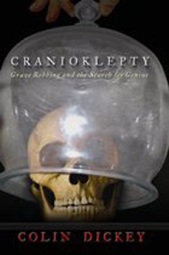
Cranioklepty: Grave Robbing and the Search for Genius
by Colin Dickey
 Our grim fascination with the autopsies of prematurely passed stars and starlets – the craving for those intimate, if clinical, details of the body – is not just a modern phenomenon.
Our grim fascination with the autopsies of prematurely passed stars and starlets – the craving for those intimate, if clinical, details of the body – is not just a modern phenomenon.
Take the case of Elizabeth Roose, a Viennese actress who died in childbirth in 1808. The critically acclaimed scion of a prominent theater family, Roose came to be the subject of a peculiar indignity, or distinction (it was, after all, a fate that generally only befell the famous). An accountant and amateur scientist, Joseph Carl Rosenbaum, unearthed her body weeks after her death and stole the head, hoping to carve off the remaining flesh, burn away the residue with lime, and preserve what he believed to be the most crucial signifier of human talent: the skull.
Colin Dickey’s Cranioklepty uncovers the obscure history of the study and thievery of the skull – “a scientific fetish, a secular relic” – focusing particularly on 19th century Europe. The study and reverence of skulls dates much further back, of course, but Dickey’s century is a critical one. He captures an era in which pseudoscientific theories granted the skull great authority in the study of human intelligence, talent and behavior. That gravesites and corpses still bore an aura of sanctity, and autopsies a whiff of heresy, gave skulls a totemic allure. The nearness of death – which happened at homes rather than in pale hospitals – and the beginning sparks of celebrity culture made skulls familiar and coveted and display-worthy objects.
Like a historically-minded and writerly TMZ, Dickey hounds the famous and the dead. The skull of Charlotte Corday – who famously stabbed Jean-Paul Marat in his bath – was guarded by the descendents of Napoleon Bonaparte. The German philosopher and poet Friedrich Schiller’s skull was kept on a velvet cushion in the library of a duke, “almost as if it were another book on the shelf.” Francisco Goya died in exile, and when the Spanish government sought to exhume his body 70 years later, gravediggers found no skull. The government telegrammed, “Send Goya, with or without head.” (The head remains missing to this day.) Sir Thomas Browne fretted about death and remains while he was alive, most famously in Hydriotaphia, Urn Burial; his skull passed for centuries between thieves and hospitals and libraries. The skulls of the living were studied for signs of talent, even in America – Walt Whitman’s phrenological chart, dotted with head bumps supposedly indicating brilliance, was published in the first three editions of Leaves of Grass.
But the skulls of composers Beethoven, Mozart, and especially Haydn have the most fascinating stories. Beethoven’s skull suffered serious abuse and a botched autopsy; broken fragments were sold off after World War II. Mozart’s was rescued from a mass grave, changed hands many times, and now rests in the Mozarteum.
And Joseph Rosenbaum hung on to Haydn’s for a while. He had badly botched the preservation of Elizabeth Roose’s skull and couldn’t stand the associated smells – but the actress was only a trial run for Haydn, whom Rosenbaum deeply admired, and knew well in life. Rosenbaum stole Haydn’s skull and concealed it well from the many authorities who wanted it for crypts or museums – once even popping it into bed with his wife as the police searched his home.
Haydn’s skull wouldn’t be buried again for a century. As Dickey traces the travels of these and other men’s bones – from grave to crypt to shelf, from the skilled hands of scientists to the worshipful ones of admirers, across borders and through wars and disasters – he finds that there is more to skulls than morbidity. Stealing them is something of a tribute, an act of love; studying them is at once mystical and medical, ancient and modern. Skulls today, of course, have a primarily symbolic rather than scientific currency. They long ago relinquished their status as the ultimate key of human knowledge, the seat of our selves, to the brain, the folds and grooves and chemicals of which have become our new obsession, our new keys to the mysteries of human nature.
*Photo courtesy hugovk.




Send A Letter To the Editors